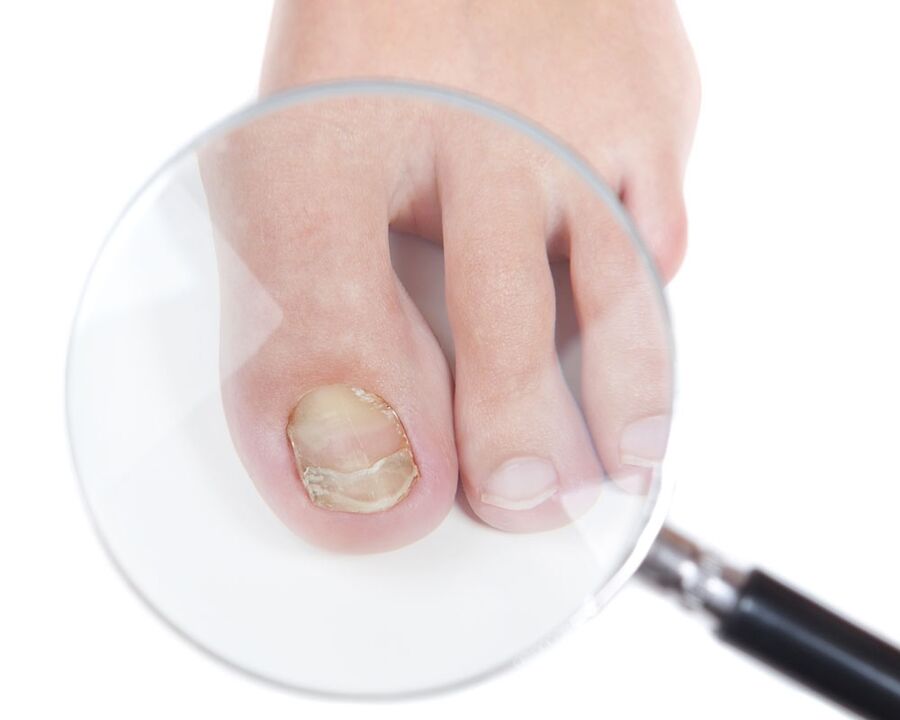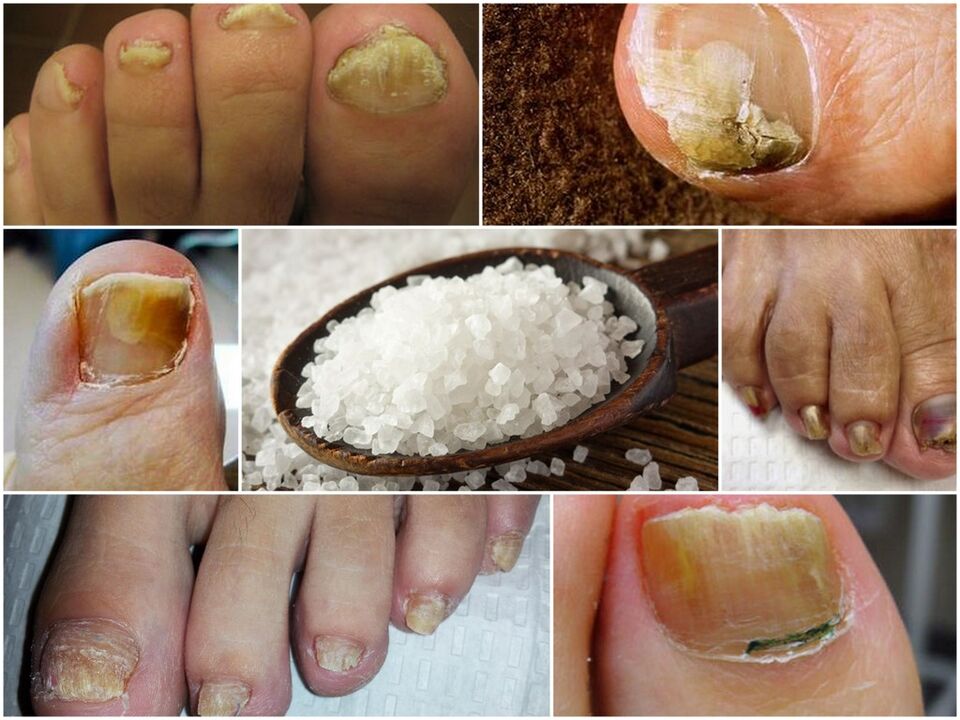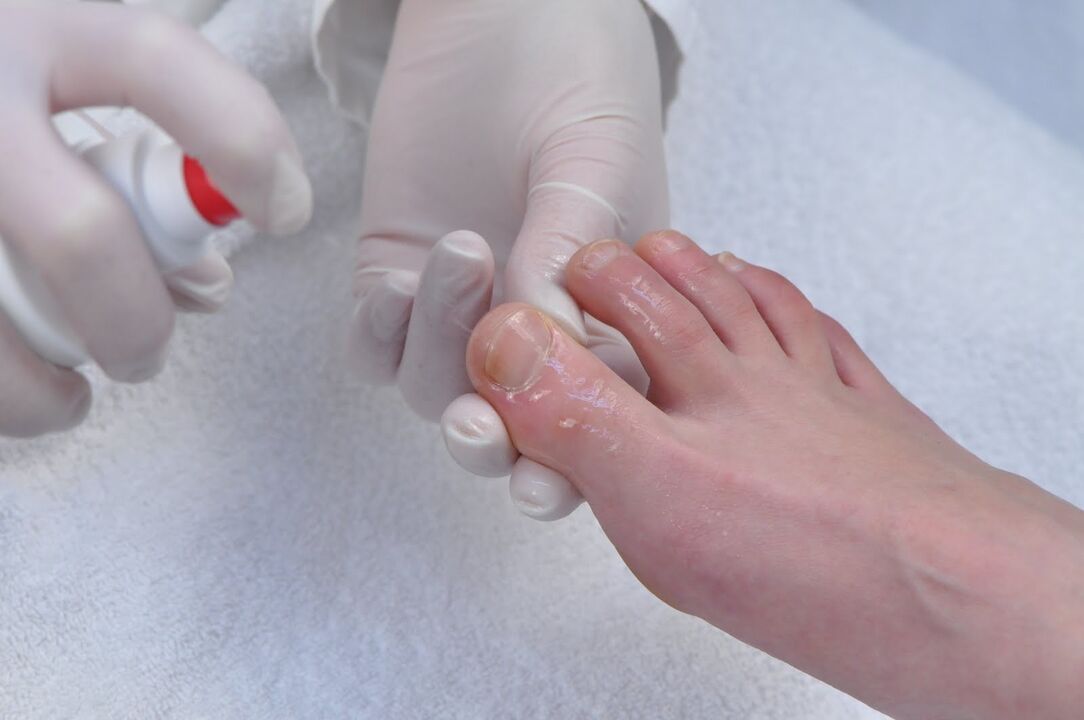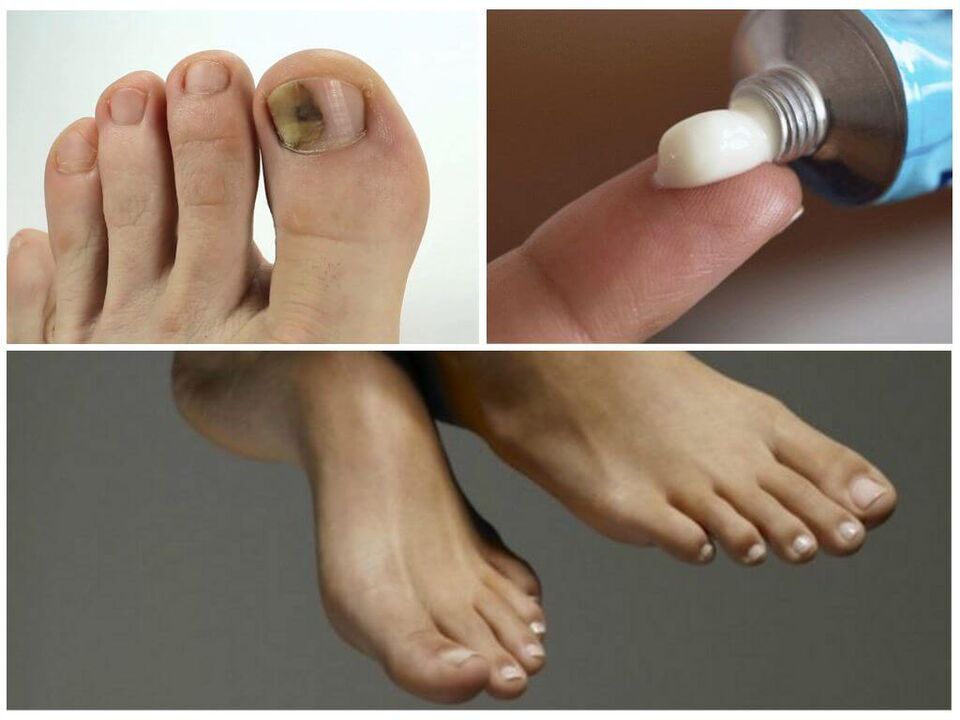The fungus of the nail plate (onykhomycosis) is a fairly common dermatological disease, from which up to 20% of the population of the planet suffers in one form or another.

One or more nails can be affected by any of the varieties of dermatophytes (microorganisms parasitizing on the human body), both on the arms and on the legs. The pathogens of onychomycosis are rapidly multiplying in a humid and warm environment, in shaded places. Infectious dermatophyte mushrooms can corrode not only nails, but also the skin and hair. Older people have a higher level of the spread of the disease.
Let us consider in more detail why the fungus appears, and we will also make a review on the 5 most effective drugs for the treatment of fungi of the nails on the legs at home.
The source of infection can be:
- Sick person. Some types of fungi are parasite only on a person, so you can get infected only from the patient. You can get infected with a nail fungus on the legs both with direct contact with the patient, and when using common objects - shoes, towels, etc.
- Animals. There are types of fungi that amaze both people and animals. People, as a rule, become infected in contact with sick pets.
- Wednesday. Another variety of fungi can multiply outside living organisms. You can get infected in contact with soil or water.
Thus, you can get infected anywhere. But, of course, not every contact with the pathogen ends with the fact that the fungus develops on the nails of the legs. The following provoking factors can lead to the development of onychomycosis:
- age after 60 years;
- diabetes mellitus;
- circulatory violation in the lower extremities;
- weakening of immunity caused by a chronic disease or other factors;
- Wearing an uncomfortable shoe that does not pass the air.
How does nail fungus begin? The initial stage of the fungus on the legs does not cause physical discomfort, the changes relate to the appearance of the nail plate. The fungus of nails at the initial stage is manifested by the appearance of stains or stripes of an unnatural color. If the fungus of nails on the legs at the initial stage is not treated, then the progression of the disease will begin.
The stages of the fungus
All mushrooms are prone to aggressive colonization of their carrier. The germination of mycelium in the fabric is similar to the growth of the roots of the tree in the building. By branching, the body of the mushroom destroys the cellular structure of tissues, causing destruction.
It's all about their way to absorb food. Mycelium distinguishes enzymes that destroy the dead keratinocytes, cells of the nail plate, and absorb nutrients. Unfortunately, these enzymes affect not only dead cells, but also violate the work of healthy ones.
The progression of the disease takes place in five stages:
- Infection. The fungus attaches to the dead skin scales, gradually getting to the nail. No symptoms are observed.
- Normotorophical. The nail fades and turns around at the edges, thickens a little at the corners. The smell and unpleasant sensations appear.
- Hypertrophic. The yellowness covers the entire nail, the nail plate is deformed with the appearance of transverse coloring. In 60 % of cases, it is accompanied by a thickening of the entire nail. The edge of the nail plate is loosened, delaxed.
- Atrophic. Pieces of the nail plate disappear, exposing the nail bed, covered with loose horn masses. The nails are dull, yellowish gray.
- Onycholisis. The nail plate becomes thinner and disappears. If the matrix is not hurt, the nail will grow.

For us, the good news is that mycelium does not penetrate living fabrics. He sufficiently dead cells, and if it enters the nail bed, the mushroom immediately attacks with immunity and dies. However, with prolonged infection, impaired trophic of the nail leads to a weakening of barrier function, and pieces of mycelium can go into the bloodstream in search of a new fertile place. In addition, the constant fight against the mushroom depleted the reserves of immunity.
Diagnostics
To confirm the diagnosis, the specialist gives the patient a referral for tests:
- Microscopy. The scraping removed from the nail plate processes a special substance to destroy keratin. In this form, the material is easier to study under a microscope. The disadvantage of microscopic research is the impossibility of determining the type of fungus. However, the analysis answers already serve as the basis for the appointment of antimycotics of a wide spectrum of action.
- Cultural research. In laboratory conditions, the material is placed in the nutrient medium of the saburo - sowing for the rapid development of the fungus. The causative agent is identified by color, growth rate and the shape of the parasite colonies. The technique also reveals the sensitivity of strains to drugs. But the patient receives the results of the analysis only 3-5 days after its conduct.
- DNA diagnostics. The detection of DNA cells of fungal infection occurs when a scraping of a nail affected by dermatophytes or candidal fungi occurs. The method does not determine molds. The results of the analysis of the patient are given within 1 to 2 days. The disadvantage of the DNA diagnosis of onychomycosis of the stop is the high cost due to the need to use special equipment.
External symptoms of the fungus are not specific, they only indicate damage to the nails on the legs. The cause of the disease becomes clear only after diagnostic studies. To prescribe adequate therapy, onychomycosis of the stop is differentiated from red flat lichen, psoriasis of nails, keratoderma and other diseases that cause violation of nail nutrition.
How to treat a fungus at home
Do not hope that the fungus will pass on its own. The longer a person suffers from this disease, the more complicated the further treatment will be.
The duration of the course of treatment and the selection of medicines depends on:
- Stages of the disease.
- The degree of damage to the nail.
- Clinical form of the disease.
Before the start of active actions, it is necessary to minimize the negative impact of the external environment, eliminate the reasons why the fungus appeared under the nails on the legs:
- A warm and humid environment is ideal for the growth of various microorganisms, try to dry shoes all the time after walking, wear socks only from natural materials that provide normal heat and air exchange;
- The foot fungus often appears due to poor immunity, you can just step on the floor with your bare foot, and pick up the infection, take vitamins to avoid this;
- Frequent nail extension can become one of the causes of onychomycosis, limit the procedure up to 1 session in six months;
- The most complicated is the sympathetic - this is a fungus caused by active disputes. They penetrate into the hollows between nails and fingers, can be in a sleep stage for some time, and then grow sharply. Most often, they are infected in places of public use (pools, showers, solariums), during the operation of other people's shoes, etc.

It is desirable to apply drugs for external use after keratolytic treatment of the nail plate.
Before each procedure for applying the medication, it is necessary:
- Make a soap-soda bath. A tablespoon of soda and salt and 50 g of laundry soap is added to a small bath. Keep the feet in the solution for about 15 minutes.
- Process a damaged nail. Using a special saw, the upper layer of the nail is undermined so that the drug is better absorbed.
- Apply a medication. The drug is applied to dry clean nails on the legs and skin around them.
When using solutions, ointments and creams, the drug is applied 2-3 times a day, varnishes-2 times a week. The course of treatment is established by the doctor depending on existing damage. If the nail plates are completely affected and local drugs do not have a positive effect, it is recommended to combine them with systemic antimycots. System preparations have a large list of contraindications and should be prescribed by the attending physician. Most of them are forbidden to take during pregnancy and lactation, in childhood and chronic diseases of the liver and kidneys.
In severe cases, a sub -gear fungus may require removal of the nail plate. The procedure can be carried out both surgically and using keratolytics that contain salicylic acid and urea. Removing the affected nail with keratolytic plasters is distinguished by its painlessness and convenience. After steaming the legs, the patch is neatly applied to the affected nail plate and sealed with adhesive plate. After a few days, the patch is removed, the affected areas of the plate are cut, one of the antifungal drugs are applied. The procedure is performed several times.
To get rid of the fungus of the legs, it will not work so quickly. It will take about 6-12 months for the treatment of onychomycosis, depending on the form of the disease, stage and its course. After all, complex therapy involves the use of various drugs and the recovery period, during which the dermatologist prescribes a supporting course. Nail fungus is not only a cosmetic disadvantage, but a serious disease that reduces the body's protective functions. Against the background of weak immunity, dangerous pathologies can develop. Timely diagnosis and treatment will avoid problems associated with onychomycosis. Therefore, you need to follow your health carefully.
5 best folk remedies for the treatment of nail fungus
Natural folk remedies are quite effective for onychomycosis in its early stages. Most of them are used at home really help to get rid of the disease.
Hydrogen peroxide
The hydrogen peroxide perfectly removes the nail fungus on the legs in a neglected (chronic) form, but the treatment will be quite long. Dermatologists recommend lubricating the perhydrot daily (once every 2 days) and healthy nails in the process of getting rid of pathology to prevent their infection.
So, how to cure a neglected fungus of nails on the legs using hydrogen peroxide?

- Method 1. In a basin (bucket), steam the legs and try to remove (cut, scrape) from the nail plates the affected crust. Dip the gauze swab in the perhydrola and attach to the treated nail. Wrap with a film on top. Repeat the procedure twice a day before the growing of a healthy nail plate.
- Method 2. Combine the perhydrol to apple vinegar in equal amounts. To impregnate the gauze napkin with the resulting composition and attach it to the corrosive ailment to the nail. Wait for the end of the spike effect. Rinse your legs with running water, dry thoroughly. Next, apply a pharmaceutical drug prescribed by doctors.
- Method 3. Screw the feet in hot water with the addition of liquid laundry soap or copper sulfate, dry. A cotton pad, abundantly moistened with peroxide, put on the affected nail, cover with a piece of film, fix the bandage with a strip of bandage. Hold the compress for 35-40 minutes, scrape the softened tissue, eaten by a fungus. Next, treat the surface with an antifungal drug prescribed by an infectious disease specialist.
Vinegar
Treatment of onychomycosis in an advanced vinegar (wine, apple) is a proven and effective way. To obtain the expected result, it is important:
- Use a natural product without chemical additives;
- Observe proportions in the compositions;
- Follow the treatment regimen;
- Use only your things.
We take sour baths
Prepare a basin (bucket), where you can conveniently place the feet. Pour heated water and vinegar into it (in equal quantities). Fingers should be completely covered with purifying liquid. The duration of the session is 40-50 minutes. Sessions must be repeated until the injured cornea is completely replaced. In the complicated stage of onychomycosis, the bath should be carried out with the simultaneous use of pharmaceuticals that the mycologist will prescribe.
We make vinegar compresses
Pour into a bowl 2 tbsp. tablespoons of apple cider vinegar, prepare a cotton swab (disk), polyethylene film. Pierce the cotton wool with vinegar, attach to the infected cornea, wrap (not too tight! ) A film. Leave for 3-3. 5 hours. The total duration of vinegar therapy is 2. 5-3 months. You can stop sessions only when a new nail plate is completely formed. Even a small amount of left infected tissue can provoke the return of the pathological process.

Tea tree oil
Before use, make sure that you do not have an allergy to this drug. Apply a little oil on the wrist and leave for 12 hours. If irritation did not occur, you can safely use. The entire course lasts two months and includes steaming or direct application. For a bath, 5 drops of oil are added per liter of water. An undiluted extract is applied with a cotton swab to the surface of the nail after steaming the legs in soapy water. It is not necessary to rinse it.
Fungus prevention
One of the most effective means that the fungus is "afraid" is high -quality prevention.
It is very important to maintain the normal function of the immune system, for which the correct diet (minimum of alcohol and coffee, maximum vegetables, proteins) is necessary. In a weakened organism, the infection spreads very quickly. It should be known and clearly observe the rules of personal hygiene. Those who do this sharply reduce the likelihood of infection. There is no need to explain why you can’t wear someone else's shoes, use personal hygiene products. You can also not walk barefoot in pools, saunas, baths, on the beach. You’ll have to wipe your legs dry after a shower. You’ll know how to disinfect places where the fungus can be theoretically. In the absence of special products against the fungus, ordinary white can be used for this. Remember that the manifestation of nail fungus is always much easier to prevent than to get rid of this unpleasant ailment.
















